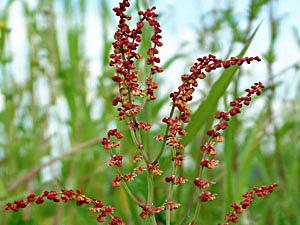
medicinal herbs
Sheeps Sorrel
Rumex acetosella

Herb: Sheeps Sorrel
Latin name: Rumex acetosella
Family: Polygonaceae (Buckwheat Family)
Medicinal use of Sheeps Sorrel:
Sheep's sorrel is a detoxifying herb, the fresh juice of the leaves having a pronounced diuretic effect. Like other members of the genus, it is mildly laxative and holds out potential as a long term treatment for chronic disease, in particular that of the gastro-intestinal tract. The plant is also part of a North American formula called essiac which is a popular treatment for cancer. Its effectiveness has never been reliably proven or disproven since controlled studies have not been carried out. The other herbs included in the formula are Arctium lappa, Ulmus rubra and Rheum palmatum. The whole plant, used in the fresh state, is diaphoretic, diuretic and refrigerant. A tea made from the leaves is used in the treatment of fevers, inflammation and scurvy. The leaf juice is useful in the treatment of urinary and kidney diseases. A leaf poultice is applied to tumours, cysts etc, and is a folk treatment for cancer. A tea made from the roots is astringent and is used in the treatment of diarrhoea and excessive menstrual bleeding.Description of the plant:

Plant:
Perennial
Height:
30 cm(11 3/4 inch)

Flowering:
May toAugust
Habitat of the herb:
Heaths and acid grasslands. A weed of acid soils.Edible parts of Sheeps Sorrel:
Leaves - raw or cooked. A delicious lemon-like flavour, most people consider them too strong to use in quantity, but they are excellent as a flavouring in mixed salads. The leaves should only be used in small quantities due to the oxalic acid content. The leaves can be used as thickeners in soups etc, they can also be dried for later use. Root - cooked. It can be dried, ground into a powder and made into noodles. Seed - raw or cooked. Easy to harvest, but the seed is rather small and fiddly to use. A drink similar to lemonade (but without the fizz) is made by boiling up the leaves.Other uses of the herb:
Dark green to brown and dark grey dyes can be obtained from the roots, they do not need a mordant.Propagation of Sheeps Sorrel:
Seed - sow autumn or spring in situ. Division in spring.Cultivation of the herb:
Heaths and acid grasslands. A weed of acid soils.Known hazards of Rumex acetosella:
Plants can contain quite high levels of oxalic acid, which is what gives the leaves of many members of this genus an acid-lemon flavour. Perfectly alright in small quantities, the leaves should not be eaten in large amounts since the oxalic acid can lock-up other nutrients in the food, especially calcium, thus causing mineral deficiencies. The oxalic acid content will be reduced if the plant is cooked. People with a tendency to rheumatism, arthritis, gout, kidney stones or hyperacidity should take especial caution if including this plant in their diet since it can aggravate their condition.Plant information taken from the Plants For A Future.
